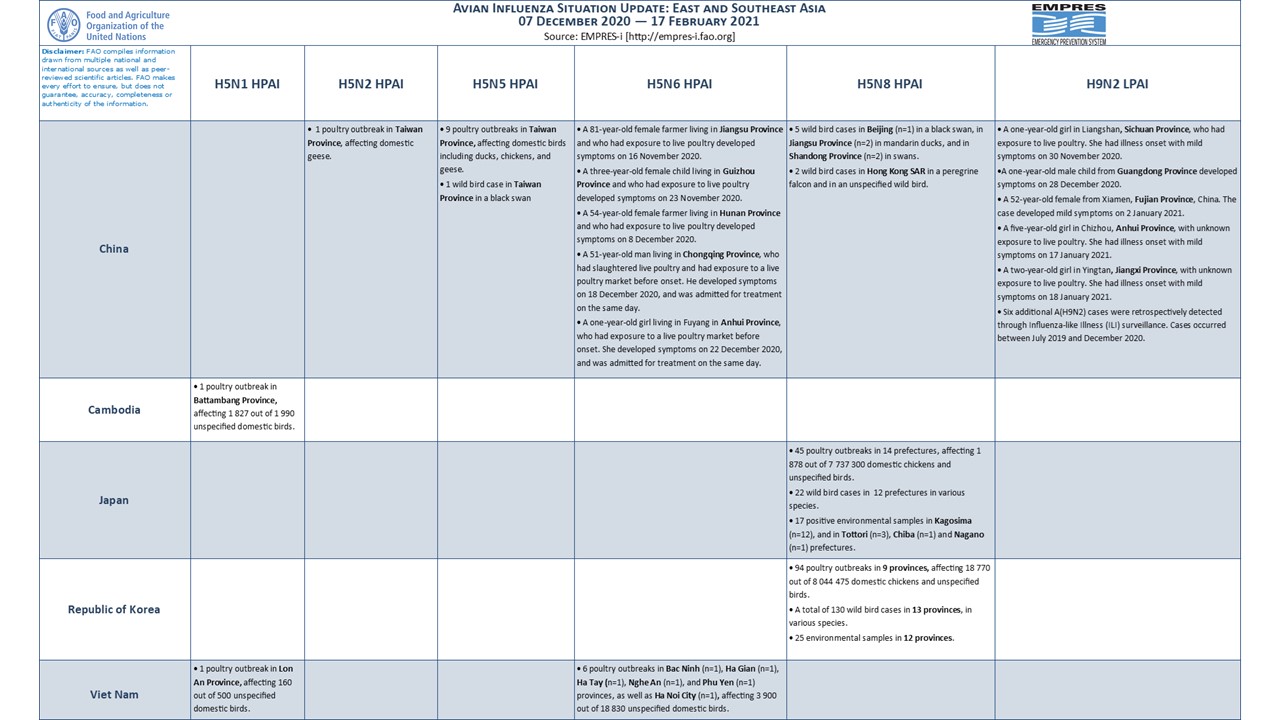FAO/EMPRES-AH is constantly monitoring the avian influenza situation worldwide and compiles information from multiple national and international sources as well as peer-reviewed scientific articles. Close collaboration with country and regional offices, the implementation of avian influenza field surveillance projects, and networks of expertise like OIE/FAO’s OFFLU (www.offlu.net) provide access to timely information on outbreaks, surveillance findings, and genetic similarities of circulating viruses or their virological features. This information is stored in the EMPRES Global Animal Disease Information System (EMPRES-i), a database that can be accessed online at empres-i.fao.org.

Asia and southeast Asia from 07 Dec to 17 Feb 2021 © EMPRES-i
During the period 7 December 2020 to 17 February 2021, five highly pathogenic avian influenza (HPAI) virus subtypes (H5N1, H5N2, H5N5, H5N6, and H5N8) and H9N2 low pathogenic avian influenza (LPAI) have been reported in East and South-East Asia. Two H5N1 HPAI outbreaks were reported in smallholder farms, one in Battambang Province, Cambodia affecting 1 827 out of 1 990 unspecified domestic birds, and another in Long An Province, Viet Nam affecting a total of 160 out 500 unspecified domestic birds. In addition, six H5N6 HPAI outbreaks were reported in Viet Nam in five different provinces and Hanoi City, affecting 3 900 out of 18 830 unspecified domestic birds. Taiwan Province, China reported one H5N2 HPAI and nine H5N5 HPAI outbreaks in domestic birds including chickens, ducks, and geese, as well as two HPAI detections of H5 and H5N5 virus subtypes in a Northern Pintail and in a Black Swan, respectively.
H5N8 HPAI continues to circulate in East Asia, with at least 45 outbreaks reported in 14 prefectures in Japan, and 94 outbreaks reported in nine provinces in Republic of Korea. In addition, H5N8 HPAI virus was detected in various wild bird species (e.g. buzzards, cranes, falcons, mallards, and swans) in Japan (n=22) and in Republic of Korea (n=130), and in environmental samples collected through active surveillance in both countries. China reported seven H5N8 HPAI events in wild birds, five occurring on mainland in Beijing (n=1), Jiangsu Province (n=2), and Shangdong Province (n=2), and two cases detected in Hong Kong SAR.
H5N8 HPAI viruses detected in East Asia shares high genetic similarities with the one that was circulating in Europe during the first half of 2020. However, a recent H5N8 virus sequence collected from a wild bird in Japan shows higher similarity with H5N8 HPAI viruses that emerged in July-August 2020 in Central Asia, suggesting an introduction of two distinguishable H5N8 virus strains by wild birds in Japan during the autumn-winter of the Northern hemisphere.
Furthermore, China reported five A(H5N6) human cases in Anhui, Chongqing, Guizhou, Hunan, and Jiangsu provinces, and five A(H9N2) human cases in Anhui, Fujian, Guangdong, Jiangxi, and Sichuan provinces. The majority of these human cases had known exposure to live poultry, and all occurred either in young children or in adults over fifty years old. Recently, China reported six additional A(H9N2) human cases that were retrospectively detected through influenza-like illness surveillance and occurred between July 2019 and December 2020.
Highly pathogenic H5N1, H5N2, H5N5, H5N6, and H5N8 viruses have demonstrated the ability to spread via migratory water birds.
We consider avian influenza activity to be highest in the period from December to March, therefore reports of outbreaks in poultry or detections in wild birds and humans are not expected to increase over the coming months in the region.

![]()
![]()




